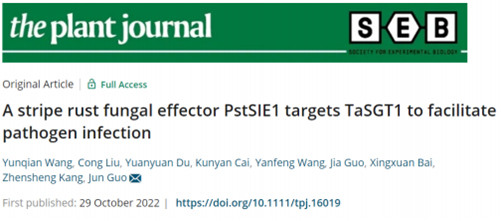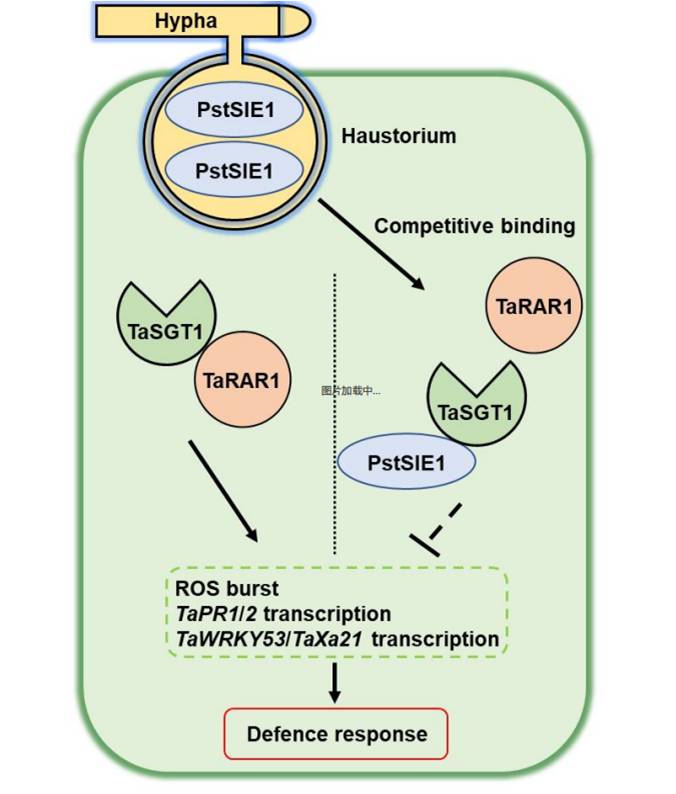On October 29th, a research paper entitled " A stripe rust fungal effector PstSIE1 targets TaSGT1 to facilitate pathogen infection " was published online by The Plant immunity research team of our College of Plant Protection in the internationally famous academic journal, The Plant Journal. The identification of a stripe rust specific effector, PstSIE1 (SGT1-Interacting Effector 1), that interacts with wheat TaSGT1 elucidates the ability of PstSIE1 to interfere with TaSGT1-TaRAR1 complex formation and suppress wheat immunity to promote bacterial infection. Prof. Jun Guo at our college is the corresponding author of the paper, and Dr. Yunqian Wang and Cong Liu are the co -first authors of the paper.

Wheat stripe rust (Puccinia striiformis f. sp. tritici, Pst) is a strictly obligate parasitic fungus, and it severely compromises wheat growth and threatens food security in China. The immune system works in a timely and efficient manner when plants encounter pathogenic infections. SGT1, as an important immune factor in plant defense signals, not only participates in plant broad-spectrum resistance and many disease resistance genes (R genes) mediated disease resistance responses, but also fulfills chaperone function by interacting with RAR1.Therefore, identifying and obtaining stripe rust effector targeting wheat's important immune regulatory factor TaSGT1 and clarifying the mechanism of pathogen effector regulating plant immunity will be of great significance for developing new stripe rust prevention and control strategies.
In the wheat rust interaction, TaSGT1 was significantly induced. Transient silencing of TaSGT1 and inoculation with stripe rust revealed a significant reduction in hydrogen peroxide (H2O2) accumulation and an increase in the mycelial area of the fungus in the silenced plants, indicating TaSGT1 as a positive regulator of immunity in wheat immunity. The rust specific effector PstSIE1, which interacts with TaSGT1, was identified by screening a yeast two-hybrid library using protein interaction technology. Further creation of the PstSIE1-RNAi stable silencing lines after inoculation revealed that the infection induced accumulation of H2O2 was significantly up-regulated, and the expression levels of the defense-related genes TaPR1, TaPR2, TaWRKY53 and TaXa21 were significantly increased. Whereas the PstSIE1 overexpressing lines showed the opposite trend compared with the silencing plants after inoculation, indicating that PstSIE1 is an important causal agent of stripe rust.
SGT1 interacts with RAR1 through its CS domain to form a protein complex, and individual silencing and co silencing experiments revealed that TaSGT1 and TaRAR1 may form a complex to exert disease resistance functions. Further studies found that PstSIE1 was able to competitively bind to TaSGT1 with TaRAR1 in vivo and in vitro, speculating that PstSIE1 acts through target TaSGT1 and interferes with TaSGT1-TaRAR1 complex formation to suppress host immunity. This study was the first to identify PstSIE1, a rust specific effector that targets TaSGT1, an important immune regulator in wheat, and it clearly demonstrated that it competitively binds to TaSGT1 and promotes bacterial infestation, thus providing a gene resource and theoretical basis for sustainable wheat stripe rust control.

A schema for suppression of wheat immunity by the rust specific effector PstSIE1
This study received technical support from the experimental platform of the State Key Laboratory of Crop Stress Biology in Arid Regions and was supported by grants from the National Key R & D Program (2021YFD1401000), the National Natural Science Foundation of China (32172381, 31972224 and 32102175), the Key R & D Program of Shanxi Province (2021ZDLNY01-01), the Natural Science Basic Research Development Program of Shanxi Province (2020JZ-13 and 2021JQ-144) and the 111 Project of Ministry of Education (B07049)
Original links: https://onlinelibrary.wiley.com/doi/10.1111/tpj.16019